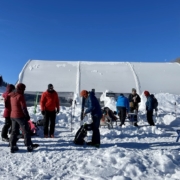Backcountry Tips & Tricks, Part 3: Personal Care
Let’s Get Personal
Self-care is group care — you are no good to the group if you’re too cold, hungry, or tired to travel safely, make group decisions, or assist in a potential rescue situation. Here are some tips for how to care for your personal needs while touring.
Properly layer before hitting the skin track, it will help make your ascent more efficient. Photo: Justin Wilhelm
Dressing the Part
- Layers are your best friend – Multiple versatile layers are more beneficial than a few thick layers. This way, you have more options for the unpredictable mountain weather. Carry various layers including a waterproof jacket, insulated layers, and wind protection. It takes time to find the perfect combo so test out different options before settling on your go-to layering system.
- Stay warm, but not too warm – Be bold and start cold on the skin track. You’ll quickly warm up when going uphill. Try to prevent excessive sweating, as this leads to wet layers, and be cautious of long periods with no movement. Most people lose heat very quickly when they stop moving in cold conditions. About 200 feet from the summit or your stopping point, put an extra layer on, then continue uphill to build heat before stopping. Check out more tips on staying warm in the backcountry here.
- Keep your skin covered – Exposure to the sun and cold can be lead to serious ramifications. Make an effort to keep as much of your skin covered as possible, and put sunscreen on whatever is exposed to the skin. Buffs are the best neck protection for both spring sunshine and winter cold. And don’t forget the brimmed hat, even when it’s negative temps!
Never forget the brimmed hat on a sunny day. Photo: Justin Wilhelm
Fueling for Success
- Eat more than you think you’ll need — You may not know how many calories you’ll burn on any given backcountry tour, but we can assure you that on cold days your body will use more energy (in the form of calories) working to keep itself warm. Make sure to fuel up before touring, and have carbohydrate and fat-rich foods for snacks throughout the day.
- Always carry snacks in accessible pockets — If you start to bonk on the skin track, digging through your pack to find snacks is even more frustrating than usual. Keep some snacks in your pockets for breaks or transition periods. Bonus: putting energy bars in your chest pocket helps keep them warm … because no one likes biting into a frozen energy bar.
- Stay hydrated — It’s easy to forget to drink water when it’s cold out and you’ve got powder fever. No matter the air temps, being at elevation and in windy conditions more quickly leads to dehydration. Carry warm water in a thermos; it’s easier to drink when it’s cold out and helps keep you warm & hydrated.
Take the time to prepare a good breakfast before hitting the skin track, your stomach will thank you later. Photo: Justin Wilhelm
Treating Aches and Pains
- Prevention is key — It’s worth a bit of pre-work to prevent any injuries or pain while in the backcountry. Make sure your boots fit well, you have the right layers for the weather, you’re physically able to accomplish your goals, and there’s no underlying injuries you’re ignoring to search out fresh powder. It’s easier to treat any aches and pains while at home than when you’re in a cold, wet, exposed environment.
- Carry what works for you — The basic first aid kits are great as a starting point, but if you know that Aleve works better than Ibuprofen for you when your back seizes up, add that to your bag! Personalize your first aid kit in a way that works for you, while still carrying the essentials.
- Duct tape those blisters — It may sound strange, but it does the trick. The minute you feel a blister coming on, pull out your repair kit or first aid kit, dry off the area around your hotspot, and apply some tape on top of the blister or hot spot. Duct tape sticks better than Moleskin, removes relatively easily, and prevents friction between your skin and boots.
- Worship your feet — You’ll spend most of the day (or week) on your feet when touring, so treat them kindly! Make sure to pre-apply duct tape (as mentioned above) or blister dressings to areas you know you easily get blisters. Give your feet some breathing room by not buckling your boots too tight, and follow these tips on how to keep your feet warm.
Loosely buckle your boots for the uptrack to prevent loss of circulation or blisters. Photo: Justin Wilhelm
Mentally Prepare
- Pay attention to where your head’s at – Backcountry touring can be mentally taxing. After all, you’re dealing with many variables and potentially life-threatening terrain. If you’re having a mentally off day, or not feeling great, share this with your group before leaving the trailhead, or give yourself permission to take a rest day. Being mentally aware is important for backcountry travel.
- Listen to your body — The human brain can be astonishingly strong — even when our bodies are telling us to take a break. Physical exhaustion can lead to potentially life-threatening situations if you’re far from help. Make sure you’re both physically and mentally prepared and feeling good before embarking on a backcountry tour.
Checking in with your group makes for more fun throughout the day! Photo: Erik Lambert
Take personal care seriously in the backcountry — this habit helps keep the excitement alive for more adventures. It also shows your ski buddies you care about being a good backcountry partner and ultimately this benefits all parts of your backcountry touring experience. Check out Part 1 of this series focused on education and Part 2, all things gear to complete your backcountry tool kit. We hope this 3 part Tips & Tricks blog helps you feel more confident when exploring winter environments.













